Framing Titian’s poesie
by The Frame Blog
Titian’s first commissions from the Habsburg family came from the emperor, Charles V. In 1533, for example, he ‘improved’ upon a Seisenegger portrait of Charles with a version which created a more regal and better-proportioned image.
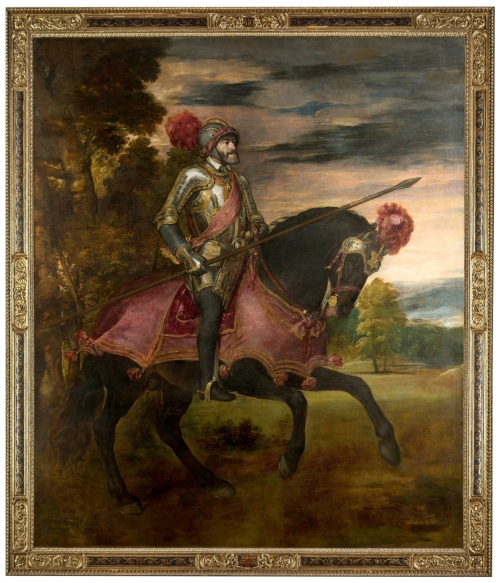 Titian (1490-1576), Emperor Charles V at Mühlberg, 1548, o/c, 335 x 283 cm., now in 20th century frame by La Casa Cano of Madrid, Museo del Prado
Titian (1490-1576), Emperor Charles V at Mühlberg, 1548, o/c, 335 x 283 cm., now in 20th century frame by La Casa Cano of Madrid, Museo del Prado
In 1548 he spent nine months in Augsburg, out of which came the magnificent equestrian portrait of the Catholic monarch returning like a triumphant Arthurian knight from routing the Protestant Schmalkadic League (Charles had, in fact, attended the battle on a stretcher, so this image was equally a triumph of propaganda). This sojourn in Augsburg produced around twenty court portraits in all, including one of the Empress Isabella, who had died nine years earlier.
Titian’s mythological series
Titian (1490-1576), Sisyphus, 1548-49, o/c, 237 x 216 cm., now in Prado gallery frame, Museo del Prado
Titian was commissioned at the same time to paint a series of four large mythological subjects for the sister of Charles V, Mary of Hungary, ruler of the Netherlands. These depicted the torments visited on those who had rebelled against the gods, such as Tityus (condemned, like Prometheus, to have his eternally-regenerating liver eaten by birds of prey), and Sisyphus (always pushing his vast stone up a just-unconquerable hill).
Anon. 16th century artist, Mary of Hungary receiving Charles V at her castle in Binche, watercolour; no size, no location
These paintings, known collectively as the Furies, were installed within architectural, sculptural frames in the great hall of Mary’s newly-built palace at Binche in Hainault, as a dreadful warning to anyone who might conceive of rebelling against their divinely-ordained ruler (Sisyphus seems to be the painting on the extreme right of the interior, above). In some respects therefore they may be seen as the dark twin – the antithetical mirror – of Titain’s poesie: a series of mythological works designed to be installed in a single room, and to be read partly for their symbolic meaning.
Titian had also, from 1518-23, worked on another suite of mythological paintings which had been commissioned by Alfonso I d’Este for his camerini d’alabastro in the Castello Estense, Ferrara. This was dismantled in 1598, and the pictures were taken to Rome [1]. When the empty camerini were surveyed two years later for Cesare d’Este, the camerino dei marmo was described as ornamented with foliage and rosettes carved in stone, marble friezes, cornices and pilasters, and lined in pink and white marble; by 2002, only two marble doorways remained [2].
Studio of Camillo Filippo (d.1574), Camerino dei Baccanali, appartments of Alfonso II d’Este, Castello Estense, Ferrara. Photo: Sailko
A surviving wall of later frescos in Alfonso II’s apartments shows the manner of integrating pictures into these rooms with trompe l’oeil architectural elements, which probably reflect the actual architectural settings in the earlier camerini.
Set into Alfonso I’s decorative interiors were paintings and sculptures by Dosso Dossi, Antonio Lombardo, and Bellini (Alfonso had initially hoped that Bellini would complete the whole cycle – in the end, he painted one picture, in 1514). Raphael was also approached, but never produced the two works commissioned. It was Titian who, four years after Bellini, produced The worship of Venus and The Andrians, followed in 1522-23 by Bacchus and Ariadne; he then repainted the background of Bellini’s offering to harmonize with the rest
Titian, Philip II, and the poesie
Because of his history, therefore, and his established connections with the Habsburgs, Titian was the painter most likely to be called upon both for large thematic schemes of painting and for validatory portraits by Charles V’s heir, Philip. On his father’s abdication of his various crowns in 1556, Philip was to follow him as King of Spain and ruler of the Netherlands – although not onto the thrones of Germany and Austria.
Possessions of Charles V in 1556, from The Cambridge Modern History Atlas, ed. Sir Adolphus William Ward, G.W. Prothero, Sir Stanley Mordaunt Leathes, & E.A. Benians, London, 1912
Wars against creeping Habsburg control (half of Europe was Charles’s by the time he retired in 1556), and the financial burden this imposed, forced the splitting of his kingdoms between his son, who became Philip II, and his brother Ferdinand, who became Holy Roman Emperor. Philip inherited Spain, Portugal, the Netherlands, and sizable chunks of Italy – Naples, Sicily and Milan – but even this diminished realm was fraught with debt, loans and bankruptcy, which may explain something of the situation within which works of art were commissioned.
Titian (1490-1576), Philip II, 1551, o/c, 193 x 111 cm., 20th century frame by La Casa Cano of Madrid, Museo del Prado
Titian had met Philip as he was returning from Augsburg to Venice in late 1548; he painted the portrait of the then 21 year-old prince in Milan, and Philip also commissioned copies of this portrait. In 1549 Charles recalled Titian to Augsburg, having presented Philip in public as his heir, and 1550-51 Titian painted the prince again, supplying further copies; he also painted The fall of man for the father of Philip’s secretary, Antonio Pérez.
Galerie François I, Château de Fontainebleau, 1530-47
It was during this particular period that he appears to have been commissioned by Philip to create a series of mythological paintings, the subjects and treatment of which were left up to the artist. There was at first no idea of an integrated thematic hang (unlike the series painted for Mary of Hungary and for Alfonso I d’Este) within a single room, although the Museum’s catalogue entry for Venus and Adonis notes that François I’s decorative scheme of the 1530s-40s in Fontainebleau was ‘a source of inspiration for Philip II’.
Titian (1490-1576), Danaë and the shower of gold, 1551-53, o/c, 114.6 x 192.5 cm., 19th century French-style Baroque revival frame, Wellington Collection, Apsley House, London
Titian (1490-1576), Venus and Adonis, 1554, o/c, 186 x 207 cm., revival cassetta frame, 19th or 20th century, Museo del Prado
However, in 1554, Titian suggested in a letter to Philip that his projected Venus and Adonis was another ‘poesia’ – a pendant to Danaë which would be displayed with it:
‘Because the figure of Danae, which I have already sent to Your Majesty, is seen entirely from the front, I have chosen in this other poesia to vary the appearance and show the opposite side, so that the room in which they hang will seem more agreeable. Shortly I hope to send you the poesia of Perseus & Andromeda, which will have a viewpoint different from these two; and likewise Medea & Jason.’ [3]
Titian (1490-1576), Perseus & Andromeda, c.1554-56, o/c, 183.3 x 199.3 cm., 19th century revival of an Italian Baroque leaf frame, Wallace Collection
Although the Venus and Adonis was in this way envisaged (post factum) as a pendant to the Danaë, it was very different in size and shape; but the linking of the two works seems to have developed from this point into the idea of the poesie as a series. The next work was, as Titian had indicated, Perseus and Andromeda, which was based on the dimensions of the Venus and Adonis, and begun just as the latter was being completed, in 1554 [4].
Titian (1490-1576), Diana and Callisto, 1556-59, o/c, 187 x 204.5 cm., 19th revival of a Baroque garland frame, National Gallery & National Galleries of Scotland
Titian (1490-1576), Diana & Actaeon, 1556-59, o/c, 184.5 x 202.2 cm., 19th revival of a Baroque garland frame, National Gallery & National Galleries of Scotland
The Jason and Medea which had been intended to accompany Perseus never materialized; and the latter was followed in 1559 by Diana and Callisto, and then by Diana and Actaeon, both of which left Spain in 1704, passed through the Orléans collection, and by 1793 had arrived in the UK.
Titian (1490-1576), The Rape of Europa, 1562, o/c, 178 x 205 cm., 19th century British oak garland frame, Isabella Stewart Gardner Museum
The last of the poesie to be sent to Philip was The rape of Europa, which was finished in 1562. The death of Actaeon was the final associated painting, but it seems to have remained in Titian’s studio until his death [5].
Questions of framing and hanging
The six + one paintings of the poesie, assembled for the 2020 exhibition Titian: Love, Desire, Death (whether, in some cases, the originals or not, according to academic argument), had all, after their various travels, ended up in 19th century frames. When the idea of reframing them for the exhibition arose, in order to give an impression of visual unity and of their presence together in an architecturally and decoratively coherent interior in a Spanish palace, a difficulty immediately presented itself. They had never been installed in that kind of specifically designed interior, in the same way that the mythologies in Alfonos d’Este’s camerino or the Furies in Mary of Hungary’s castle had been, and as both artist and patron may have projected for them; they were never hung in quite that way until c.1623, nearly half a century after Titian’s death and two years after the death of Philip’s heir, Philip III.
Charles Fitzroy points out that the eroticism of their treatment would have made any collector other than the king liable to heavy fines and possible excommunication: hence their disappearance into a fog of silence once they were in Philip’s possession, so that the location and setting in which they were displayed remains a matter of guesswork [6]. He also notes that Philip’s life in Spain was one of constant movement between one palace and the next, as he travelled between those in Madrid, Toledo and Aranjuez, probably with most of the furnishings he required in a hefty baggage train (although it is difficult to imagine how an increasing collection of canvases, all around six feet by seven, was moved from palace to palace by horse and cart; would they have been in temporary frames? removed from the stretchers and rolled?).
Antoon van den Wijngaerde (1525-71), View of Madrid from the West, pen & colour wash, 1562, & detail of the Alcázar
The Diana and Callisto and Diana and Actaeon had been delivered to the Alcázar, where Philip received them in the summer of 1560, and this is suggested as one of the most likely homes for all the poesie, since they were there in the 17th century; the other is the Palace of Aranjuez, where Philip relaxed in his gardens. Looking back to the connection with Fontainebleau, and its inspiration for the hanging of a series of mythological paintings, the galleries there were located beside the gardens [7]. Unfortunately, apart from the rebuilding and additions which continually remade parts of the palace, the Alcázar burned down completely in 1734, and the Palace of Aranjuez in 1748; so nothing remains of the buildings of Philip II’s era to hint at the room where the paintings might have hung.
Given the models of which Philip was aware, it seems reasonable to conclude that some sort of architectural setting must have been envisaged by the king. However, no definite location was agreed for such a scheme, due to Philip’s deteriorating health, the unfinished state of the palace of the Alcázar, and his political exigencies. The way in which they were displayed in his lifetime may be illuminated, however, by what happened to them during the reign of his son:
‘…while Philip II celebrated the pagan beauty of Titian’s art, his son, Philip III (r.1598-1621) hid the poesie away from view, ordering the nudes immediately covered whenever the queen or other women approached.’[8]
Titian (1490-1576), Jacopo Strada, 1567-68, shown in frame with curtain in David Teniers (1610-90), Archduke Leopold Wilhelm in his picture gallery in Brussels, c.1651, Kunsthistorisches Museum, Vienna
In order for them to be covered quickly, they must have had curtains installed on the frames: and the painting above right has, fortuitously, a nice example of a Titian portrait shown in the mid-17th century with a curtain on a rail fixed to its frame. It is true that Teniers was inventive with the framing and display in his various iterations of the Archduke’s collection, and that the Jacopo Strada portrait may have had a completely different frame and no curtain; however, it is evidence of the use of curtains in 17th century galleries [9]. This also means that, for the fixings of the rails to be added (usually small metal brackets at each end of the top member) the poesie must have been housed in wooden frames; and that this method of display must have carried over from the lifetime of Philip II into the reign of his heir, since, if Philip III felt uneasy about their display, he was extremely unlikely to have reframed them. This also disposes of any likelihood of an interior with stone architectural frames, like the Great Hall at Binche or the Ferrara camerino.
There are no records or images of the interior of the Alcázar in Philip II’s lifetime, but we know that it was thought by later generations to be austere in comparison to, for example, the Palais de Versailles; and we do have an analogue in the Escorial, and a stylistic hint in Philip’s own instructions to his architect, Juan de Toldeo, that the palace should have:
‘simplicity in the construction, severity in the whole, nobility without arrogance, majesty without ostentation.’[10]
Both Toledo, who oversaw the building of the Escorial until he died in 1567, and his assistant and successor, Juan de Herrera, who accomplished it in 1584, followed Philip’s conception of a restrained classical vocabulary in the Italian style, both within and without.
‘Herrera’s designs have been called cold, academic, & monotonous by his detractors…’ [11]
Pompeo Leoni (c.1533-1608), Jacome da Trezzo (1515-1589) and Juan Bautista Comane ( ?- 1582), High altarpiece of San Lorenzo de El Escorial, 1579-88, designed by Juan de Herrera. Madrid
The chapel of San Lorenzo de El Escorial illustrates the kind of frame which Herrera provided in sober classical style for Philip II: the main altarpiece was to his design [12]. It is regular, Italianate, restrained and unornamented; all its liveliness comes from the parcel-gilding and the contents. Secular works were probably framed for the king in an equivalently plain and spartan style. Nothing more can be extrapolated from what we know of Philip II and the poesie whilst in his and his son’s possession.
Questions of reframing
Given this dearth of information, when it came to reframing the series for the exhibition, there were only two logical options – to frame the paintings either as Titian would have envisaged them in ‘the room in which they hang’, or in a contemporary Spanish style, erring on the austere side. The problem with the latter is that there are so few examples of secular framing of anything like these large mythologies in the last quarter of the 16th century: the majority of frames in this most Catholic of countries were made either for sacred subjects or for portraits.
Rubens (1577-1640), Albert VII of Austria and Isabella Eugenia, c. 1618 & 1609, o/oak panel, both 105 x 74 cm., in Spanish parcel-gilt ebonized ripple frames, Kunsthistorisches Museum, Vienna. Photo: faun070
We do know that frames made of ebony, stained and polished fruitwood or ebonized (painted) wood, either unornamented or decorated with wave and ripple mouldings, had been brought from Germany to Spain via Flanders, and through the agency of travelling craftsmen – just as they had been taken to those regions of Italy which were ruled by Philip. In the Netherlands these frames were fashionable bourgeois items, but in Spain they were associated with the court and with the religious art of the Counter-Reformation. According to an inventory made in 1630 of seventeen paintings belonging to the 1st Marqués de Leganés, at least five of them were recorded as having ebony frames: one of these, Raphael’s Madonna and Child with SS Isabel and John, was 170 cms high ‘with a massive ebony frame with mouldings’ [13].
This type of frame was clearly unsuitable for Titian’s mythologies, in scale, tone and colouring; and with so few further clues available, the first option was followed – to frame them in a way that Titian could have accepted as an overall scheme. Once again, however, there was a lack of information – Titian being one of the painters whose work has been so consistently desired and collected over the centuries that it has also been consistently reframed, as it has passed from owner to owner and from interior to interior. The few frames with claims to having retained their original frames include The Annunciation in the Scuola Grande di San Rocco, previously owned by Titian’s patron, the orator Melio da Cortona; the tympanum of Giorgione’s Christ carrying the Cross, also in the Scuola; St John the Baptist in the Accademia, Venice; and Titian’s last great work, the Pietà.
Titian’s Pietà and its frame
Titian (1490-1576), Pietà, 1575-76, o/c, 353 x 347 cm., Gallerie dell’Accademia, Venice
This had been planned to hang over his tomb, first in his native parish church in Pieve di Cadore (replaced in 1763, although the 16th century campanile remains); then in the Chapel of the Crucifix in the Frari, Venice [14]; and then – when the friars refused Titian permission to hang the Pietà over the altar there, instead of the crucifix – back in Pieve di Cadore again. When the plague visited Venice, and both Titian and his Orazio son died, the artist was buried in the Frari, and his grave marked by a tile in the floor. The Pietà was transferred to the workshop of Palma il Giovane, a late assistant of Titian, who finished it; when he died in 1628 it went to the now defunct church of Sant’ Angelo in Venice, and thence to the Accademia in 1814.
Titian, Pietà, detail of frame: centred bay leaf torus on the top edge; cross-cut acanthus; dentils; enriched guilloche; raking leaf & hollow; astragal-&-double bead; cross-cut acanthus at the sight edge
Titian, Pietà, detail of frame: scale (41 cm. wide)
The Pietà has a very beautiful 16th century compound profile frame, which is almost certainly the original – it is too large and too unusual a shape to have been reframed easily in a contemporary period frame, and the corner configurations are unchanged; also, had it been framed on Palma il Giovane’s death for presentation to the church, it would have been given a Baroque pattern, and if thereafter, successive patterns according to the fashion. Given Titian’s age, and the fact that he was painting the altarpiece for what he hoped would be his mortuary chapel, he would have done for himself what artists customarily did for their patrons, and provided for the frame whilst the painting was in progress. It has a rare seven orders of ornament, closely packed in a wide shimmering braid of complex facets, centred on a convex moulding decorated with a wide guilloche; the centres of the guilloche are enriched with what seem to be small pomegranates – the symbol of resurrection.
This was judged to be the best possible choice of frame to unite the six poesie, because of its connection to Titian, and the chance that he might have chosen a version of this frame (or something like it) had he been commissioned to paint the series for a Venetian patron; also in large part for its aesthetic sympathy. Peter Schade, head of framing at the National Gallery, visited the Accademia to measure and photograph the frame of the Pietà in detail.
Making the frames for the poesie
Cutting the giant poplar boards to size
The frames use the same species of wood from which Titian’s own frames would have been made, including the frame for the Pietà. This is the fast-growing European Black Poplar, which is fully mature in around forty years, reaching the width of the boards in the image above; it has a close grain and when dry it doesn’t tend to split. The Gallery buys a whole trunk, which is ordered about six months in advance and arrives cut into massive boards. These are sawn into frame-sized planks in the workshop, and then the profile is shaped by hand (mechanical saws which produce machine-cut mouldings are a product of the industrial revolution in the 19th century; the shaped wood which they extrude has a uniformity which undermines the sculptural art of the workshop).
The profile of the frame; François Loudwig carving; a finished carved moulding
The first frame carved and joined
The frames were joined using screws; this is actually just compatible with the invention of wood screws if one accepts the statement, made pretty well universally, that the screw as a device for fastening pieces of wood together was developed in the mid-16th (or even, probably by a misreading of the 1500s, in the mid-15th) century. No verifiable sources are cited anywhere immediately accessible for this statement [15]. Renaissance frames in reality used hand-forged iron nails, with the odd dowel where the head might be visible. For these replicas, the back-frame was fixed by half-lapped joints, and the outer mouldings, from the dentils to the top moulding, were slotted into this and the mitres glued and pinned.
When each frame had been carved and fixed together, it was covered with fine silky veils of gesso until the ornament had softened and cohered into one organic whole. This was then painted with a yellow bole (gilder’s clay) with the tops of the ornament picked out in a deep brownish plum colour. This was specially mixed by eye from a blend of French, German and Canadian bole, to give both depth and variety to the surface, and to help with the appearance of ageing.
The process of gilding; corner showing gilder’s bole & gold leaf applied; gessoing, bole and finishing by Amanda Dickson; frames in various stages of patination
The gilding was done with 23.5 carat gold leaf, and used roughly 875 leaves per frame, each taking around five days to gild and burnish. The patination then pulled all the various stages together into one harmonious whole, which would perfectly complement the colour, tone, nationality and period of the paintings. Accurate full-scale reproductions of each work are used in the process; this is a reversal of the original method, in which the artist finishes his work in the frame to ensure the harmony of the whole work of art.
The finished frames
Titian (1490-1576), Danaë and the shower of gold, 1551-53, o/c, 114.6 x 192.5 cm., in new Pietà frame, Wellington Collection, Apsley House, London
Titian (1490-1576), Venus and Adonis, 1554, o/c, 186 x 207 cm., revival cassetta frame, in new Pietà frame, Museo del Prado
Titian (1490-1576), Perseus & Andromeda, c.1554-56, o/c, 183.3 x 199.3 cm., in new Pietà frame, Wallace Collection
Titian (1490-1576), Diana and Callisto, 1556-59, o/c, 187 x 204.5 cm., in new Pietà frame, National Gallery & National Galleries of Scotland
Titian (1490-1576), Diana & Actaeon, 1556-59, o/c, 184.5 x 202.2 cm., in new Pietà frame, National Gallery & National Galleries of Scotland
Titian (1490-1576), The Rape of Europa, 1562, o/c, 178 x 205 cm., in new Pietà frame, Isabella Stewart Gardner Museum
The death of Actaeon
Titian (1490-1576), The death of Actaeon, c.1559-75, o/c, 178.8 x 197.8 cm., 16th century Venetian frame, National Gallery, London
The death of Actaeon, although begun in 1559, according to a letter from Titian to Philip II, and intended to be loosely paired with The rape of Europa, was never sent to Spain and remained in Titian’s studio at his death [16].
David Teniers (1610-90), Archduke Leopold Wilhelm in his picture gallery in Brussels, 1651, o/c, 96 x 129 cm., and detail of Titian, The death of Actaeon, Musées royaux des Beaux-Arts de Belgique
By the 1650s it was in the collection of Archduke Leopold Wilhelm of Austria, and appears in several of Teniers’s paintings of his picture galleries, along with other versions of the poesia compositions. All Teniers’s reproductions of The death of Actaeon are unusually consistent in showing it in a narrow, boring, and ineffective stained wooden moulding with gilt sight edge. It passed through the collection of Queen Christina of Sweden and the Orléans Collection, ending up in the UK, where it acquired a reproduction French Baroque-style frame during the late 19th or early 20th century.
It can be seen in the latter frame in a black-&-white postcard of Harewood House in the 1950s, in an article on the reframing of the painting by the National Gallery in 2017; this explains the choice of the present antique Venetian frame. It is fitting that it should be differently framed from the six poesie which were sent to Philip, given its history, and this distinguished it in the hang of all seven works in the 2020 exhibition at the National Gallery, so unfortunately shut down by the coronavirus epidemic.
The poesie reframed, hanging in the exhibition Titian: Love, Desire, Death
A video by the National Gallery shows the process of making the six frames
***********************************
[1] W.R. Rearick, ‘Titian’s later mythologies’, Artibus et Historiae, vol. 17, no. 33, 1996, p. 23
[2] Marco Borella, ‘I camerini del principe’, Ferrara: Voci di una Città, no. 24, June 2006
[3] Carlo Ridolfi, The life of Titian, 2010, p. 108
[4] Ibid., p. 44-47. Rearick thinks that the version of Perseus sent to Philip was given out of the collection by the king, and subsequently lost; and that the painting in the Wallace Collection is a later Titian with a different composition (Andromeda on the left of the canvas, rather than as originally on the right: a composition sketched by Van Dyck and used as the basis of his own Perseus and Andromeda by Veronese). He suggests that this was part of a second cycle of the same poesie offered to Maximilian II (HRE, 1527-76) in 1568 (p. 53)
[5] Rearick states that The death of Actaeon in the National Gallery, London, is a later version, and that an ‘original has not survived’ (ibid.; p. 48); he thinks that the NG painting was also one of the second cycle offered to Maximilian II in 1568 (p.53)
[6] Charles Fitzroy, The rape of Europa: the intriguing history of Titian’s masterpiece, 2015
[7] See the catalogue entry for one of the series of poesie still remaining in Spain, in the Prado – the Venus & Adonis of 1554 (186 x 207 cm.)
[8] Jason McCloskey, Ignacio López Alemany, Signs of power in Habsburg Spain and the New World, note 25, p. 53
[9] An earlier example of a curtain covers a portrait in the background of Marcus Gheeraerts the Younger, Sir John Kennedy of Barn Elms, 1614
[10] Fred S. Kleiner & Christin J. Mamiya, Art through the ages, 2004 ed., p. 645
[11] Entry for ‘Juan de Herrera: Spanish architect’, Encyclopaedia Britannica
[12] See Sumario y breve declaración de los diseños y estampas dela fábrica de San Lorenço el Real del Escurial, Madrid, 1589, with engravings by Pedro Perret from the design
[13] Mary Crawford Volk, ‘New light on a 17th century collector: The Marquis of Leganés’, Art Bulletin, lxxii, 1980, pp. 256-68
[14] The Chapel of the Crucifix now contains a vast marble altarpiece of 1672
[15] The only cited source currently discoverable is Georg Agricola, De re metallica, 1494-1555, reprinted 1874; English translation 1912, republished 1950. However, there is no mention in the index of hand-made forged screws, and skimming the whole book doesn’t reveal the reference cited by M. Sydor, ‘Geometry of wood screws: a patent review’, European Journal of Wood & Wood Products, 77, 2019, in which no page number is given
[16] Rearick considers the painting in the National Gallery to be a second version of the composition (the ‘original has not survived’); op. cit., p. 48


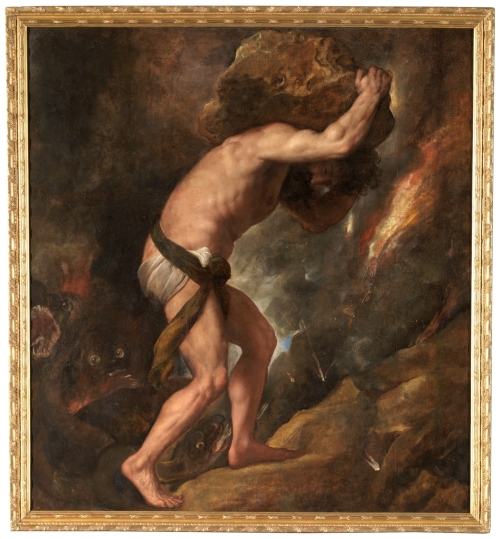










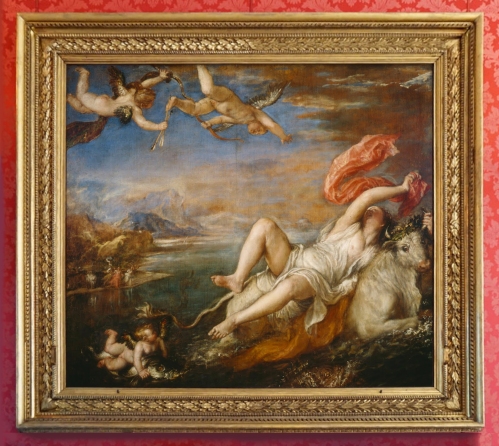




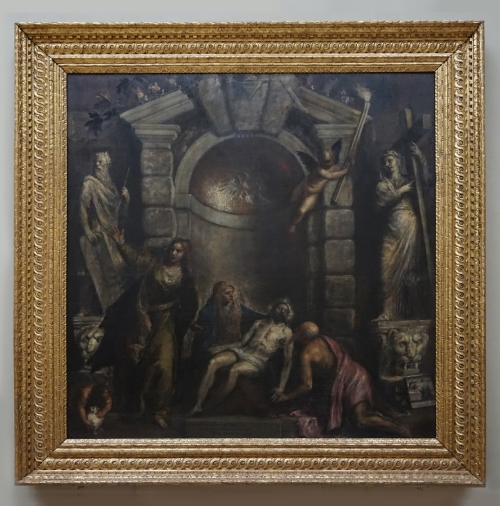


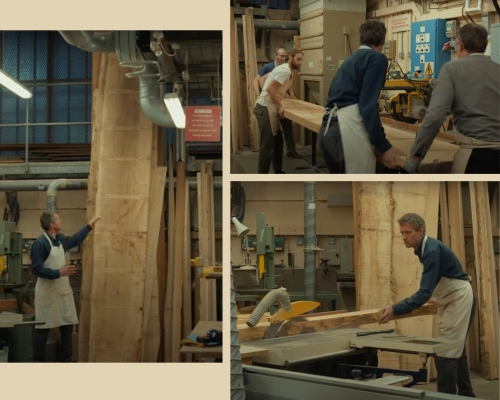
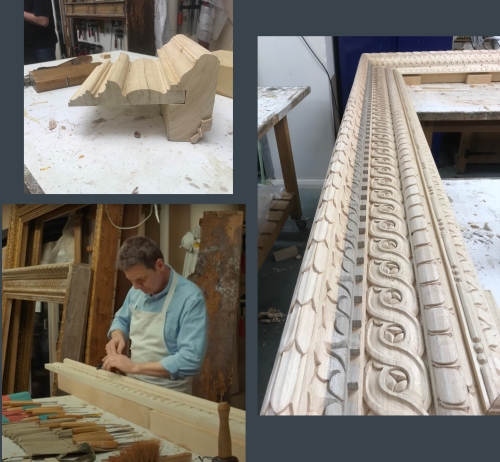
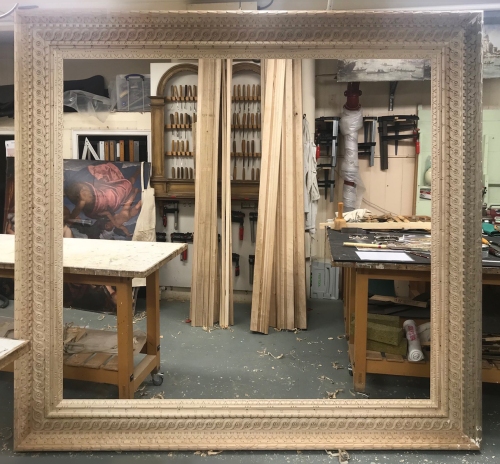
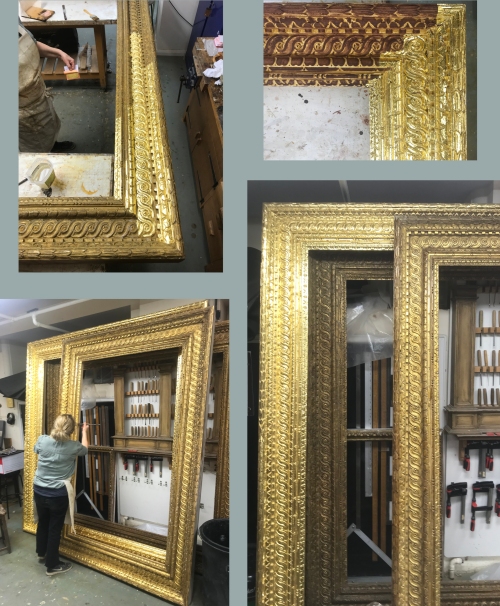



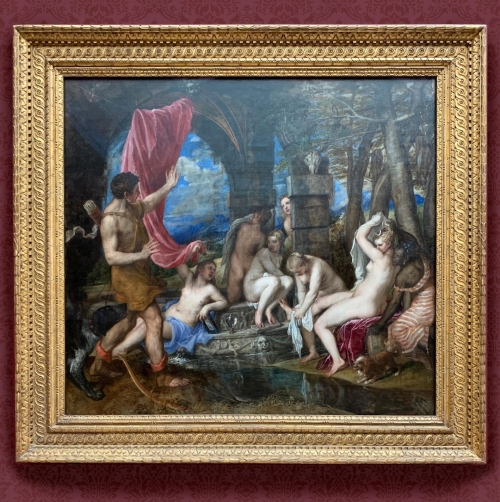






[…] Made Visual Poetry of Eroticism and Power Framing Titian’s poesie Titan’s Masterful Suite of Paintings Inspired by Ovid’s ‘Metamorphoses’ Is Being Reunited […]
LikeLike
[…] For more on Titian, see ‘Framing Titian’s poesie’. See also ‘Reasons for reframing: focusing on Titian’, for the last painting in the […]
LikeLike
Well done, Lynn.
I’m really moved to tears over the video with Peter Schade and his frame making crew. And that frame profile photo is such excellent quality to learn from. I’m so happy that I’ve gotten to see this post and thank you for including it. Not to mention how you’re installing more features on The Frame Blog. Thank you so much.
Hugs from the USA and Great American West, Barrie
LikeLike
Dear Barrie –
I’m so sorry that I missed your comment; it’s been difficult to keep up with everything. I’m very glad, though, that you enjoyed the post and the video; the latter really does give a fascinating insight into the work produced with such skill and dedication by the framing dept of the National Gallery. It is a good thing that the exhibition is going to stay open longer, so that more people here will be able to see both the paintings and the frames – and of course you may perhaps be able to see them when they travel to Boston? – I do hope so.
Thank you for such a nice message and v. best wishes,
Lynn
LikeLike